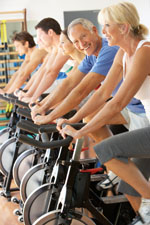
Aerobic Exercise
Although weight loss often motivates people to head to the gym, the health benefits of aerobic exercise go far beyond just helping you control your weight. A program of regular aerobic exercise can help you avoid serious health problems, such as heart disease, hypertension, stroke, diabetes, and some cancers.
It can also lower blood pressure, build stronger bones, improve muscle strength, endurance and flexibility, and improve your balance and reduce your risk for falling. Aerobic exercise is often credited for improving mood, and research suggests that it may help improve memory and other mental functions, as well.
Common aerobic exercises include walking, running, bicycling, swimming, cross-country skiing, — any activity that gets you moving and increases your heart rate.
To get the best results from your exercise, aerobic conditioning should be mixed with flexibility exercises and strength training to create a balanced fitness program.
What Is Aerobic Exercise? © 2012 Thinkstock
© 2012 Thinkstock
Aerobic exercise uses continuous, rhythmic movement of large muscle groups to strengthen your heart and lungs (cardiovascular system). When you exercise, your muscles demand more oxygen-rich blood. This makes your heart beat faster to keep up.
When you follow a program of regular aerobic exercise, your cardiovascular system grows stronger and can meet the muscles' demands without as much effort. In addition, your muscles adapt and become more efficient at performing activity.Aerobic Fitness
To strengthen your cardiovascular system, you should do prolonged aerobic exercise (ideally reaching 20 to 60 minutes of activity) intensely enough to increase your heart rate.
One of the most effective ways to gauge how hard you are working during exercise is to monitor your heart rate. Your heart rate is measured in beats per minute (bpm), and you can check it by taking your pulse periodically during your workout. Check either your radial pulse at your wrist or your carotid pulse at the side of your neck. Start with zero to count the pulse beats for 10 seconds and multiply that number by six to determine your heart rate. An efficient alternative to checking your pulse is to use a heart rate monitor, which displays your heart rate throughout your workout.
In general, to increase your aerobic fitness you should exercise intensely enough to reach your target heart rate range. Your target heart rate range is 60% to 80% of your maximum heart rate. A general formula to determine your maximum heart rate is 220 minus your age. (For example, if you are 50 years old, your maximum heart rate is 170 and your target heart rate range is 102 to 136.) Check your heart rate as you exercise and try to keep it within your target heart rate range.
In addition to checking your heart rate as you exercise, be sure to monitor how you feel. Aerobic exercise should be challenging, but you should not feel out of breath or so fatigued that you have to stop your workout.
Aerobic Training Guidelines
A safe and effective aerobic training guideline for improving aerobic performance uses a formula that includes frequency, intensity, and time (FIT).
- Frequency. Exercise aerobically 3 to 4 times a week.
- Intensity. Exercise hard enough to reach your target heart rate range.
- Time. Exercise aerobically for at least 20 minutes without stopping.
If you have a chronic health condition, are overweight, a smoker, or are middle aged or older and have never exercised, check with your doctor before starting any exercise program.
To help you stay motivated and committed to your exercise goals, choose an aerobic activity that you enjoy. Aerobics is not just running or walking — there are a wide range of activities that will get your heart rate going.
If it has been a long time since you have exercised, you can gain health benefits with just 5 to 10 minutes of aerobic conditioning. One way to start is with:
- 5 minutes to warm up
- 5 minutes of aerobic training activity
- 5 minutes to cool down and stretch
Repeat this routine 3 or 4 times a week. Gradually add time to the aerobic training portion, working up to at least 20 minutes of aerobic exercise in each session.
Healthy LifestyleThis article provides some general guidelines to help you improve aerobic fitness and gain the many health benefits associated with it. Because everyone has individual health needs and concerns, the fitness suggestions here may not be the best approach for you. The most important thing is to incorporate exercise into your daily routine and to stick with it.
Recent research shows that some health benefits can be gained by exercising at a moderately intense level for 30 minutes during most days of the week. This 30 minutes can be done all in one stretch or broken up into shorter intervals. A 10-minute brisk walk three times a day is just one way to get started on a healthier and fitter lifestyle.
Source: http://orthoinfo.aaos.org/topic.cfm?topic=A00194
